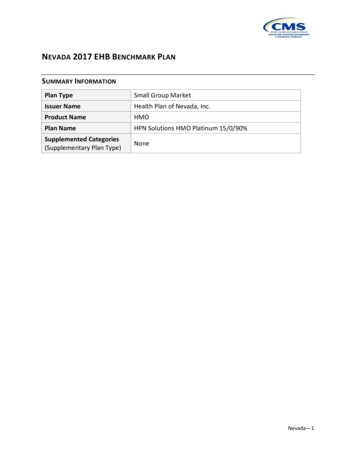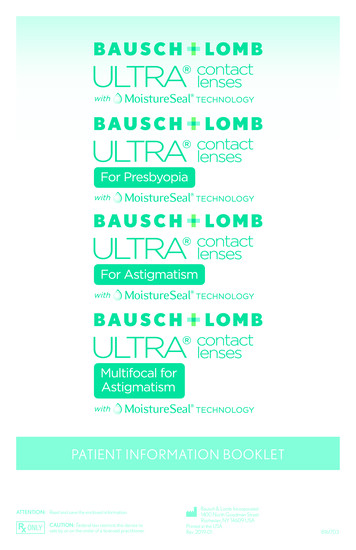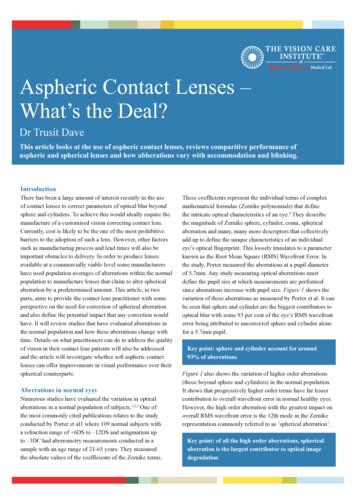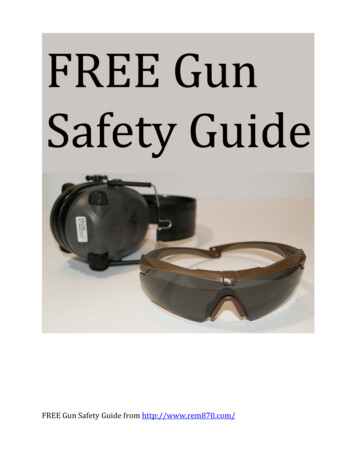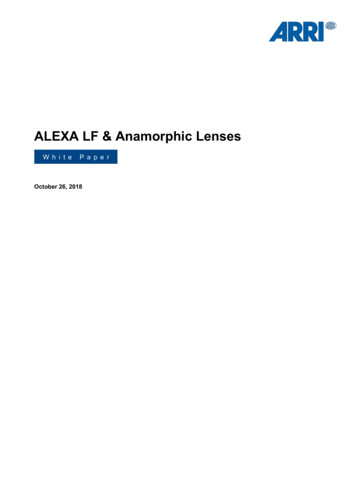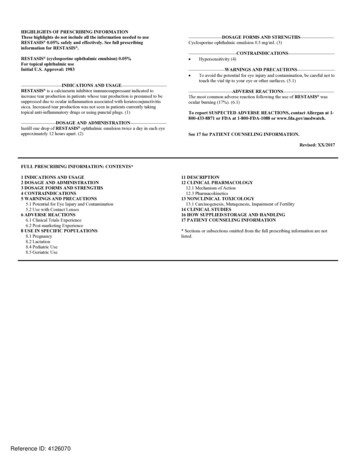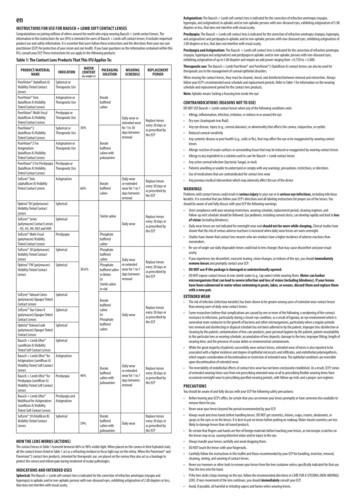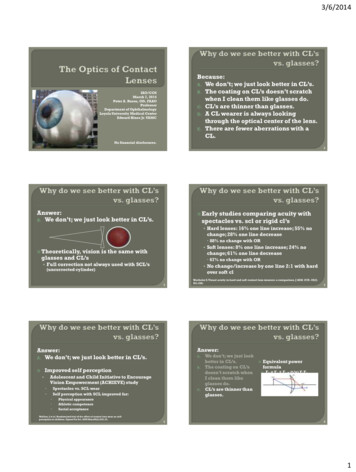
Transcription
3/6/2014Because:A. We don‟t; we just look better in CL‟s.B. The coating on CL‟s doesn‟t scratchwhen I clean them like glasses do.C. CL‟s are thinner than glasses.D. A CL wearer is always lookingthrough the optical center of the lens.E. There are fewer aberrations with aCL.IAO/COSMarch 7, 2014Peter A. Russo, OD, FAAOProfessorDepartment of OphthalmologyLoyola University Medical CenterEdward Hines Jr. VAMCNo financial disclosures.2Answer:A. We don‟t; we just look better in CL‟s. Earlystudies comparing acuity withspectacles vs. scl or rigid cl‟s Hard lenses: 16% one line increase; 55% nochange; 28% one line decrease 88% no change with OR Soft lenses: 8% one line increase; 24% no Theoretically,vision is the same withglasses and CL‟schange; 61% one line decrease 67% no change with OR Full correction not always used with SCL‟s(uncorrected cylinder) No change/increase by one line 2:1 with hardover soft cl3A. B.Improved self perceptionSpectacles vs. SCL wearSelf perception with SCL improved for: C.Physical appearanceAthletic competenceSocial acceptanceWalline, J et al. Randomized trial of the effect of contact lens wear on selfperception in children. Optom Vis Sci. 2009 Mar;86(3):222.32.Equivalent powerformula Adolescent and Child Initiative to EncourageVision Empowerment (ACHIEVE) study 4Answer:Answer:A. We don‟t; we just look better in CL‟s. Wechsler S. Visual acuity in hard and soft contact lens wearers: a comparison. J AOA 1978. 49(3)251-256.5FT F1 F2 – (t/n) F1F2CL‟s are thinner thanglasses.61
3/6/2014Answer: Spectacle magnification Axial myopia speccl Axial hyperopia Refractive myopia Refractive hyperopia spec spec spec Unencumbered fieldof view cl cl clA. B. C.D. CL closer to eye‟s entrance pupil. High ametropia: improved VF with CLBenjamin WJ. Optical phenomena of contact lenses. Clinical Contact Lens Practice. 2005 Lippincott. Chap 7A.p157 LowA CL wearer is alwayslooking through theoptical center of thelens.78Astigmatism ofOblique Incidenceorder aberrations Sphere, cylinder Higher order WhenOptical center moveswith the eyeOptic zoneaberrationsOblique rays encounterdifferent radii ofcurvature at front/backlens surfaces Essentially createsconsidering off-axis rayssphero-cylinder alongpath traveled A Astigmatism of Oblique Incidence Result: astigmatic image B Barrel/pincushion distortion Curved image with two line focicurvature of field C Coma/Chromatic aberration S Spherical aberration109Chromatic aberration Prism disperses light into spectral componentsBarrel/pincushionDistortion Blue refracted more than redImage forming raysfrom the corners gothrough peripherallens.Increased power in theperiphery magnifies orminifies corner morethan sides Creates chromatic interval Basis for duochrome test ABBE value of spectacle lenses: higher # lessCA Glass (1.523) 59; CR-39 (1.49) 58; Polycarbonate (1.58) 30Coma Off-axis peripheral rays create comet-shapeddeformity to non-axial portions of the image Plus lens pin cushion Minus lens barreldistortion11122
3/6/2014Spherical aberration Because:A. GP lenses hurt more so you have toget something out of wearing them.B. You don‟t; GP lenses move morewhich degrades the image.C. They mask astigmatism.D. There is no water content with GPlenses to degrade the image.Peripheral rays subjectto increased prismaticeffect and more powercreating blur intervalalong axisReduced,physiologically in theeye, by: Pupil acting as aperture. Flatter peripheral cornearadius of curvature. Slightly higher index of Blur intervalrefraction for nucleus ofcrystalline lens.13Because: Materials Rigid PMMA Silicone acrylates Flurosilicone acrylates Dehydrated state Hydrophilic surface Soft Hydrogel Silicone hydrogel Hydrated state: up to 70% water content Hydrophilic surfaceA.You don‟t; GP lenses move more whichdegrades the image.B. C.Line of sight stays within optic zone as lens movesThey mask astigmatism. GP mask up to 2.50 D cylinder with spherical lenses Hide surface irregularity Fluctuating vision: 14Poor surface wettingLens deposits/surface scratchesCorneal stainingToric lens rotationGP lens flexure1516BECAUSE:AN OPTOMETRIST INVENTED CL‟S.Because:A. An optometrist invented CL‟s.B. Minus cylinder was invented first.C. Mostly near sighted people wearCL‟s.D. Optometrists use minus cylinder andthey fit more CL‟s.E. We should use plus cylinder, after allthe cornea is convex.A.Theoretical da Vinci (1508)CL conceptualizedDescartes (1636)ScientistYoung (1801)Described neutralizingcorneaHerschel (1827)Astronomer/physicistProposed mold of eyeto correct visionActual Protective shell Fick (1888) Physician; diagnostic fitting; rx Kalt (1888): first? Feinbloom (1936): O.D.; PMMA 17Scleral Lenses (glass) A.F. Muller (1887): glassblowerscleral portion; glass center Obrig (1937): all PMMACorneal lenses Tuohy (1948): technician forObrig; PMMA corneal lensGP materials Gaylord (1971): chemist;assisted by Seidner brothers(OD/engineer) PolyconmaterialWichterle/Lim (1951): chemists Led to first scl 1971183
3/6/2014Because:A.B.C. Self evident: myopia more debilitating; earlier ageof onset; more availability of parametersBut, can write hyperopic or myopic Rx in eitherformOptometrists use minus cylinder and they fitmore CL‟s.D. Refraction/retinoscopy Dry (non-cycloplegic) Control accommodation by keeping both primary meridians“fogged” with plus lenses Neutralize most plus meridian with spheres; need minuscylinder to neutralize second meridian Wet (cycloplegic) Accommodation temporarily eliminated by drops Over minus during retinoscopy easier to see „With Motion‟Minus cylinder was invented first. (No)Mostly near sighted people wear CL‟s. Cornea convex; all eyes are plus powered Gullstrand‟s schematic eye: 60 D overall power Fit GP to least minus/flattest meridian; creates minusCL spectrum 2013 survey: 87% of respondents wereOD‟s24,000 ophtho in US; 35,000 OD‟s in US37 millions cl wearers in UScylinder tear layer to correct plus cylinder error Back surface toric scl Minus cylinder back lens surface (concave) Plus cylinder plus lens surface (convex)19Because:A. Some people make errors whenordering.B. It just depends on what they refracted tothat day.C. The tear layer under the CL changes thepower.D. Myopic people need more power inCL‟s.E. The vertex distance between glassesand the cornea changes the requiredpower.20Because:A. Some people make errors whenordering. B.Easy to make transposition errors going fromplus to minus cylinder-3.25 1.75x075 -1.50-1.75x165Error: 0.00 1.25x180; use planoError: -4.25 0.00x180; use „sph‟Error: use 3 digits for axis x005 not x5Can you have axis 007? Phoropter leveled; scaleIt just depends on what they refracted tothat day. Huh?21 Convert prescription tominus cylinder form.Drop cylinder power (whenrefractive equals cornealcylinder).Adjust for vertex power ifsphere power 4.00 DNo tear layer for sclCompensate for tear layer:22 Keratometry OD 43.75/45.50@105 ( 1.75x105) Accurate refraction OD -4.50 1.50x110 20/20 Trial 9.4 diam; 7.63 BC; -3.00 7.63 mm 44.25 D If BC (D) flat K: plus tear layer,add minus (SAM) If BC (D) flat K: minus tearlayer, add plus (FAP)23Convert: -3.00-1.50x020Drop cylinderVD adjustment: NoneTear layer adjustment: -0.50Final lens power: -3.50244
3/6/2014 Divergence Negative Minus vergence Moving away fromits origin Convergence Positive Plus vergence Moving toward itsDiopters – reciprocal in meters of distance fromwave front to focal point1m or 100cm or 40”XXXfocus Parallel1 -1 D 100-1m-100 cm Zero vergence1 3 D 100 .33 m 33 cm25 Point conjugate tothe retina withaccommodationrelaxed26 Effective power of lens changes if vertexdistance changes Lens moved away from eye effectively acts likemore plus power (or less minus power) Emmetropia infinity Lens moved toward the eye effectively acts like Myopia in front ofeye Hyperopia behindeye Correcting ametropia ismoving far point toinfinityless plus power (or more minus power)Formula: Fx Fo/(1-dFo) d measured in meters Positive if lens moved away from eye Negative if lens moved closer to eye27 A patient is properly corrected with a 5.00 Dlens 15mm from the cornea. What power isneeded if this lens is fit 25mm from the cornea?Fx 100/21cm 4.76DFx 5/1-(-.01)( 5) 4.76D28 What would the power be if thislens were fit as a contact lens?A patient is properly corrected with a -5.00 Dlens 15mm from the cornea. What power isneeded if this lens is fit 25mm from the cornea?Fx 100/19cm -5.26DFx -5/1-(-.01)(-5) -5.26DFx 100/18.5cm 5.41DFx 5/1-(.015)( 5) 5.41DFx 100/21.5cm -4.65DFx -5/1-(.015)(-5) -4.65DFar point20 cmWhat would the power be if thislens were fit as a contact lens?Far point2920 cm305
3/6/2014Converting fromspectacle plane tocornea plane Always relativelymore plus at cornealplane Effectivity -101- (0.013)(-10) Less cylinder if high minus More cylinder if high plus-12.00 3.00x090 12.00 3.00x090 -8.8731Because:A. You can only correct low amounts ofastigmatism with contact lenses.Because:A. You can only correct low amounts ofastigmatism with contact lenses.B. Soft toric lenses are better for you.C. Toric GP lenses hurt.D. Toric GP are hard to make. B. Frequent replacement scl torics:0.75/1.25/1.75/2.25 cylinder powersCustom powers to 10 D cylinder in SCL or GPSoft toric lenses are better for you.Higher complications with scl; better opticswith GPToric GP lenses hurt.C.* 37 million CL wearers in the US* 2013 fits and refits: 66% SH; 24% hydrogel; 8% GP; 2%hybrid* 24% soft toric; 5% spherical GP; approx 2% toric GP* Nichols, JJ. Contact Lenses 2013 Annual Report. CL Spectrum. January201432 D.Lens awareness improves with adaptation.Toric GP are hard to make.33 Spherical GP neutralizes corneal cylinder Residual astigmatism refractive cylinder34 Keratometry OD 43.75/45.50@105minus corneal cylinder Specify spherical BC Specify desired sph-cyl( 1.75x105) ExamplesK‟s: 41.00/42.25@090 ( 1.25X090)Spherical GPRx: -4.50 1.25X090or toric SCLRA ( 1.25X090) – ( 1.25X090) ( 0.00X090)Accurate refractionrx OD -4.50 1.50x110 20/20 Trial 9.4 diam; 7.63 BC; -3.00 7.63 mm 44.25 DK‟s: 43.50/44.25@090 ( 0.50X090)Toric SCL orRx: -3.25 2.25X090RA ( 2.25X090) – ( 0.50X090) ( 1.75X090) GP front toricConvert: -3.00-1.50x020Drop cylinderVD adjustment: NoneTear layer adjustment: 0.50 Final lens power: -3.50 K‟s: 42.50/45.50@090 ( 3.00X090)Toric SCL orRx: -5.50 4.50X090RA ( 4.50X090) – ( 3.00X090) ( 1.50X090) Bitoric GP35Front toric Applied to front surface Prism in lens; orientationmark Bi-toric Apply fitting paradigm toeach primary meridian Can verify 2 base curveson radiuscope and 2powers on lensometer366
3/6/2014A.B.C.D. Definition ofPrism in CL‟s corrects diplopia justlike it does in glasses.Prism in CL‟s can improve the eyesposture in an accommodativeesotropia.Prism in CL‟s can make a crossed eyelook straight.Prism in CL‟s can weight the CL tohold it in position.a prism diopter One prism diopter displaces lightone centimeter at one meter How much will a 5 prism displacean object at 40cm? 1 pd 1cm/1m 5pd X/0.4m X 2cm Prentice‟s Rule Amount of prism equals distance fromoptical center times power along thatmeridian37 Calculate the horizontal prismatic effectof decentered -6.00 D lenses for a patientwith a pupillary distance of 56 mm whenthe distance between optical centers is 68mm.38Prism in CL‟s corrects diplopia just likeit does in glasses.A.Prismatic effect depends on where you lookthrough an optical lens (same for glasses or CL)SCL essentially centered over visual axis withlittle movement Pt is viewing 68 – 56 12/2 6mm In with each eyeOD: Δ 0.6 (-6) 3.6Δ BIOS: Δ 0.6 (-6) 3.6Δ BI Total 7.2Δ BINo displacement no prism GP lens will create prism based on lensmovement optical center of lensBut small amounts; lens moves with the eye; often equal rxPrism to weight toric lensMay notice vertical imbalance if toric in one eye orsignificant anisometropia patient‟s line ofsight3940Exotropia: corrected with BIEsotropia: corrected with BOHypertropia: corrected with BDA.B.Prism in CL‟s can improve the eyesposture in an accommodative esotropia.Lateral prism: no way to maintain positionMinus spectacles cause BI effect at near Esotropia Exotropia41More esophoric decreased convergence demandOffset by less accommodative demand (less acc-conv)CL‟s: no effect on convergence; accommodate morePlus spectacles cause BO effect at nearMore exophoric increased convergence demandOffset by more accommodative demand (more acc-conv)CL‟s: no effect on convergence; accommodate less427
astigmatism with contact lenses. B. Soft toric lenses are better for you. C. Toric GP lenses hurt. D. Toric GP are hard to make. * 37 million CL wearers in the US * 2013 fits and refits: 66% SH; 24% hydrogel; 8% GP; 2% hybrid * 24% soft toric; 5% spherical GP; approx 2% toric GP * Nichols, JJ. Contact Lenses 2013 Annual Report. CL Spectrum .
